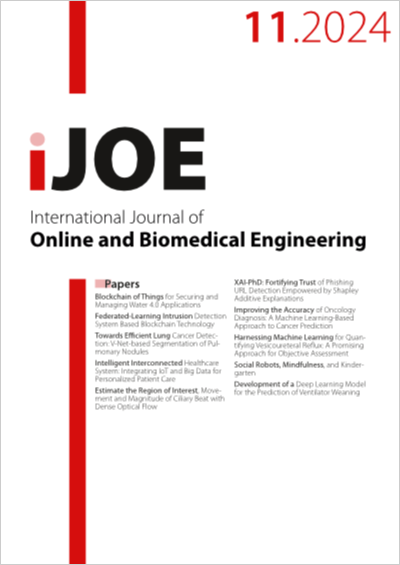Development of a Deep Learning Model for the Prediction of Ventilator Weaning
DOI:
https://doi.org/10.3991/ijoe.v20i11.49453Keywords:
Weaning, Time-frequency analysis, Continuous Wavelet transform, cnn from scractch, Bayesian optimizationAbstract
The issue of failed weaning is a critical concern in the intensive care unit (ICU) setting. This scenario occurs when a patient experiences difficulty maintaining spontaneous breathing and ensuring a patent airway within the first 48 hours after the withdrawal of mechanical ventilation. Approximately 20% of ICU patients experience this phenomenon, which has severe repercussions on their health. It also has a substantial impact on clinical evolution and mortality, which can increase by 25% to 50%. To address this issue, we propose a medical support system that uses a convolutional neural network (CNN) to assess a patient’s suitability for disconnection from a mechanical ventilator after a spontaneous breathing test (SBT). During SBT, respiratory flow and electrocardiographic activity were recorded and after processed using time-frequency analysis (TFA) techniques. Two CNN architectures were evaluated in this study: one based on ResNet50, with parameters tuned using a Bayesian optimization algorithm, and another CNN designed from scratch, with its structure also adapted using a Bayesian optimization algorithm. The WEANDB database was used to train and evaluate both models. The results showed remarkable performance, with an average accuracy 98 ± 1.8% when using CNN from scratch. This model has significant implications for the ICU because it provides a reliable tool to enhance patient care by assisting clinicians in making timely and accurate decisions regarding weaning. This can potentially reduce the adverse outcomes associated with failed weaning events.
Downloads
Published
How to Cite
Issue
Section
License
Copyright (c) 2024 Hernando Gonzalez, Carlos Julio Arizmendi, Beatriz F. Giraldo

This work is licensed under a Creative Commons Attribution 4.0 International License.



